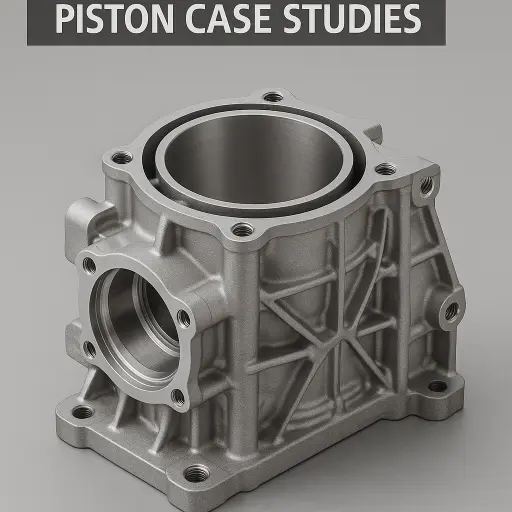Aluminum Engine Component Case Studies
Key Properties of Aluminum for Engine Applications
-
Lightweight / Low Density: Aluminum Engine Component Case Studies show significant reductions in part and vehicle weight compared to traditional cast iron, leading to better fuel economy and improved handling dynamics.
-
High Thermal Conductivity: Facilitates efficient heat dissipation from the engine, improving thermal efficiency and allowing for higher performance designs.
-
Good Castability: Easily formed into complex shapes using processes like die casting and gravity casting.
-
Good Machinability: Relatively easy to machine to precise tolerances.
-
Good Corrosion Resistance: The naturally forming oxide layer provides inherent protection.
-
High Recyclability: Aligns with sustainability goals.
-
Challenges: Relatively lower high-temperature strength, higher coefficient of thermal expansion, and potential wear resistance issues (often requiring special treatments or inserts).
Case Studies
1.Engine Block
-
Challenge: Replacing heavy cast iron blocks to achieve substantial weight savings while ensuring adequate strength, stiffness, and cylinder bore wear resistance.
-
Solution(s):
-
Utilizing high-strength aluminum-silicon alloys (e.g., A319, A356).
-
Employing High-Pressure Die Casting (HPDC) or Low-Pressure Die Casting (LPDC) processes.
-
Cylinder bore solutions:
-
Cast-in iron liners.
-
Metal Matrix Composite (MMC) liners.
-
Spray bore coating technologies (e.g., Plasma Transferred Wire Arc – PTWA, Atmospheric Plasma Spray – APS).
-
-
-
Benefit(s):
-
Significant engine weight reduction (up to 30-50%).
-
Improved front-rear weight distribution for better vehicle handling.
-
Enhanced heat dissipation, potentially allowing for optimized cooling systems.
-
Faster engine warm-up times.
-
-
Example(s): Cite specific production engines known for aluminum blocks (e.g., GM LS series, BMW inline-six engines).
2.Cylinder Head
-
Challenge: Complex geometry (ports, valves, combustion chambers, coolant passages), high operating temperatures requiring excellent thermal conductivity and heat resistance.
-
Solution(s):
-
Typically uses heat-treatable aluminum alloys like A 356 or similar.
-
Gravity Casting or LPDC to ensure the integrity of internal passages.
-
Precision machining of ports and combustion chambers for optimal airflow and combustion.
-
Often incorporates wear-resistant valve seat inserts and valve guides.
-
-
Benefit(s):
-
Excellent heat dissipation reduces knocking tendency, allowing for higher compression ratios or boost pressures.
-
Reduces weight at the top of the engine, lowering the vehicle’s center of gravity.
-
Facilitates complex port designs for improved engine breathing efficiency.
-
-
Example(s): Virtually all modern gasoline engines utilize aluminum alloy cylinder heads.
3.Piston
-
Challenge: Withstanding high temperatures and pressures, requiring low inertia (lightweight) for high RPM operation, combined with good wear resistance and thermal conductivity.
-
Solution(s):
-
Utilizing cast aluminum alloys (e.g., eutectic or hypereutectic Al-Si) or forged aluminum alloys (e.g., 4032 low-expansion, 2618 high-strength).
-
Skirt coatings (e.g., graphite, molybdenum disulfide) to reduce friction.
-
Hard anodizing or wear-resistant inserts (e.g., Ni-resist) for the top ring groove to improve durability.
-
Internal cooling galleries (especially in turbocharged/boosted engines).
-
-
Benefit(s):
-
Reduced reciprocating mass lowers inertial forces, reducing vibration and increasing the engine’s RPM limit.
-
Good thermal conductivity helps manage piston crown temperatures.
-
Forged pistons offer superior strength for high-performance and racing applications.
-
-
Example(s): Pistons in high-performance engines (e.g., Porsche, Ferrari) and modern turbocharged direct-injection engines.
4.Intake Manifold
-
Challenge: Requiring complex shapes to optimize intake airflow while demanding lightweight construction.
-
Solution(s):
-
Utilizing cast aluminum alloys.
-
(Note: Engineered plastics/composites are increasingly common here; can be mentioned for comparison).
-
Precision casting ensures smooth internal runners.
-
-
Benefit(s):
-
Lightweighting.
-
High design freedom, enabling complex features like variable intake geometry.
-
Good dimensional stability.
-
-
Example(s): Intake manifolds on many naturally aspirated and turbocharged engines.
5.Oil Pan (Sump)
-
Challenge: Containing engine oil, potentially providing structural support, and aiding in oil cooling.
-
Solution(s):
-
Die-cast aluminum alloys.
-
Designing external cooling fins to enhance heat dissipation.
-
May integrate features like oil filter mounts, oil level sensor bosses, etc.
-
-
Benefit(s):
-
Lighter than stamped steel oil pans.
-
Improved oil cooling capability.
-
Can be designed with complex shapes to contribute to powertrain rigidity.
-
-
Example(s): Oil pans on numerous mid-range and premium vehicles.
Emerging Trends and Future Outlook
-
Advanced Aluminum Alloys: Development of new alloys with higher strength, better high-temperature performance, and improved wear resistance.
-
Composites and Hybrid Structures: Combining aluminum with other materials (e.g., reinforcing fibers, ceramic particles) to create components with superior properties (e.g., MMCs).
-
Additive Manufacturing (AM / 3D Printing): Use for rapid prototyping, low-volume production, or creating complex aluminum components difficult to achieve with traditional methods.
-
Advanced Coating Technologies: Evolving surface treatments to further enhance wear resistance, corrosion protection, or thermal barrier properties of aluminum parts.
-
Application in Electrification: While the ICE market is transforming, aluminum remains crucial for electric vehicle components like motor housings, battery enclosures, power electronics casings, etc.

